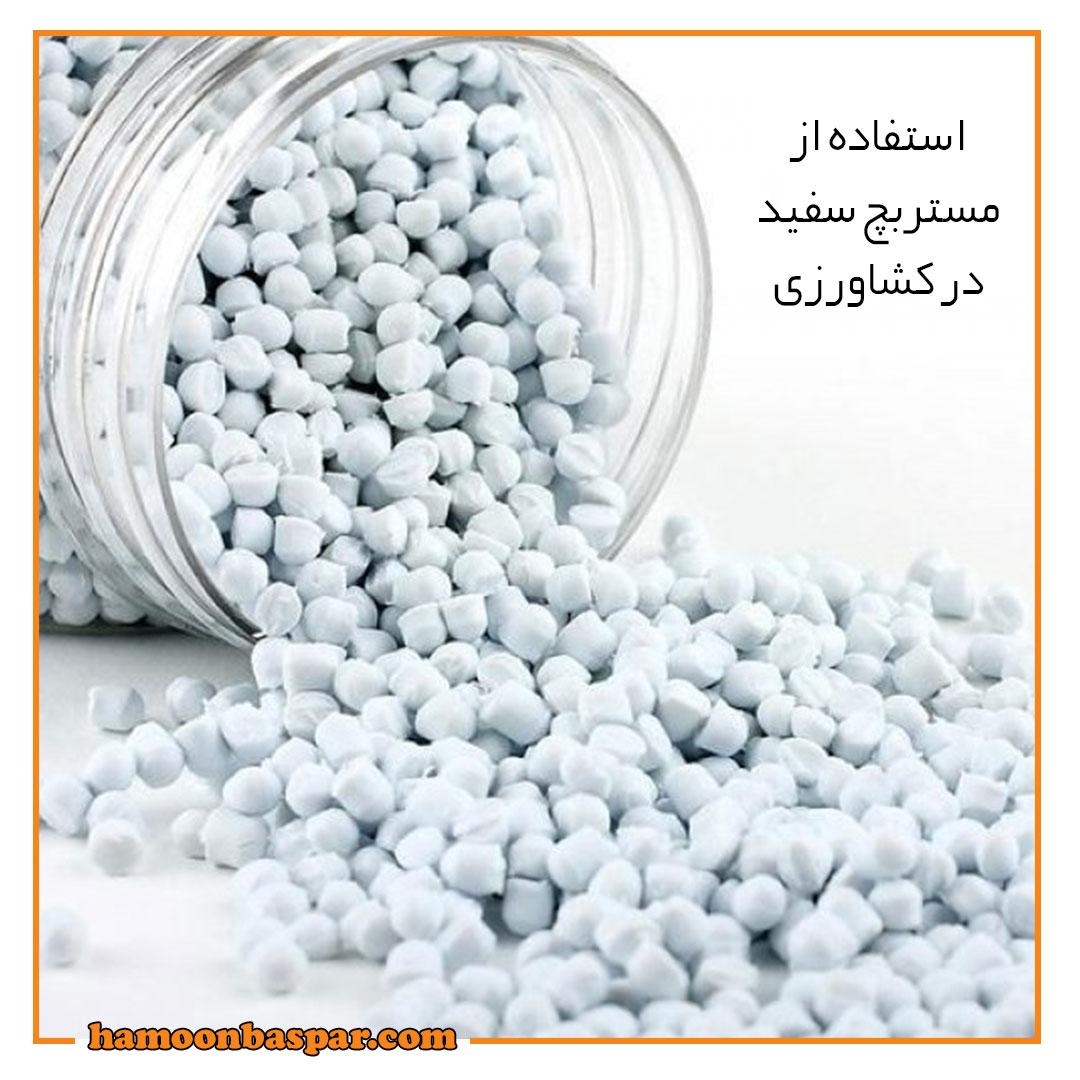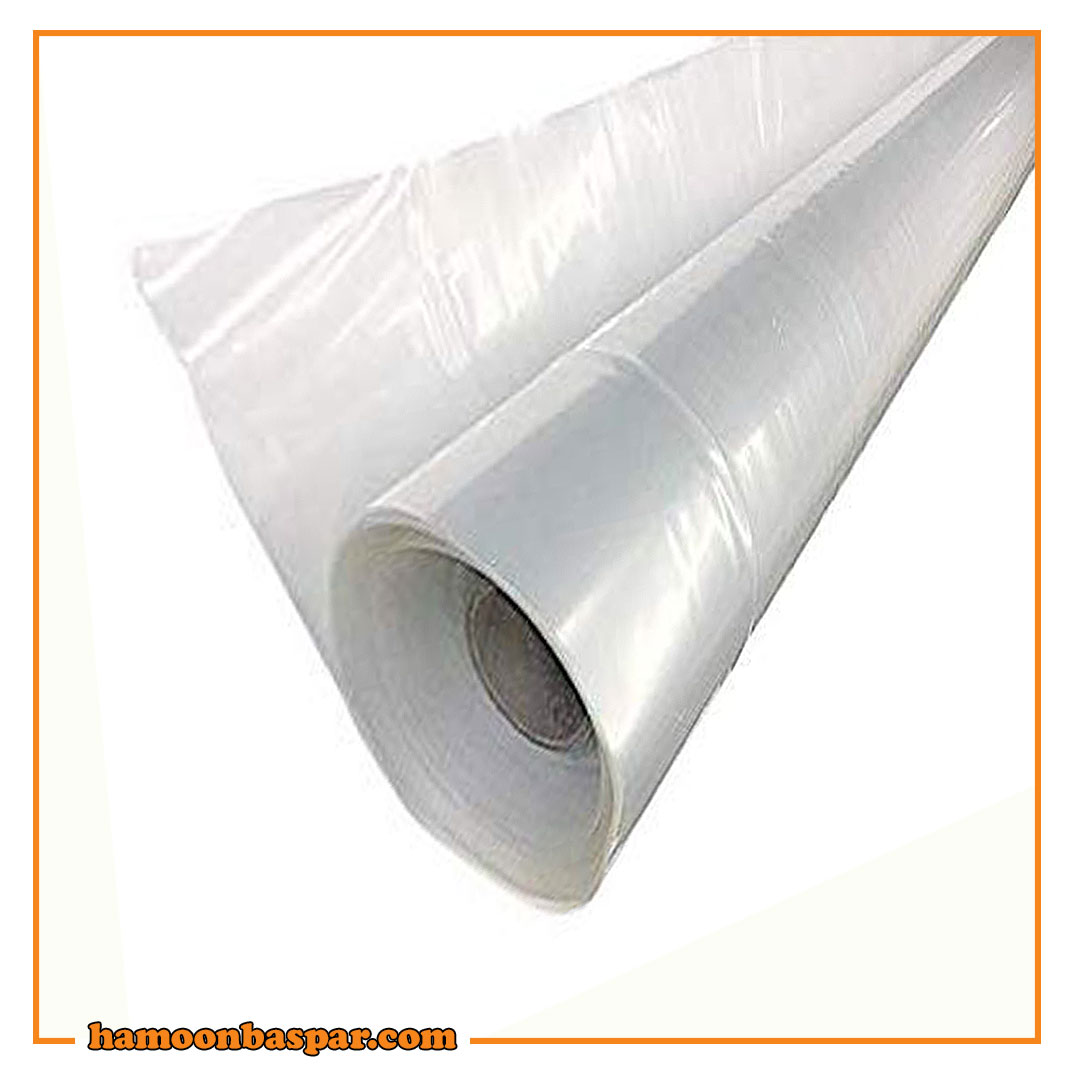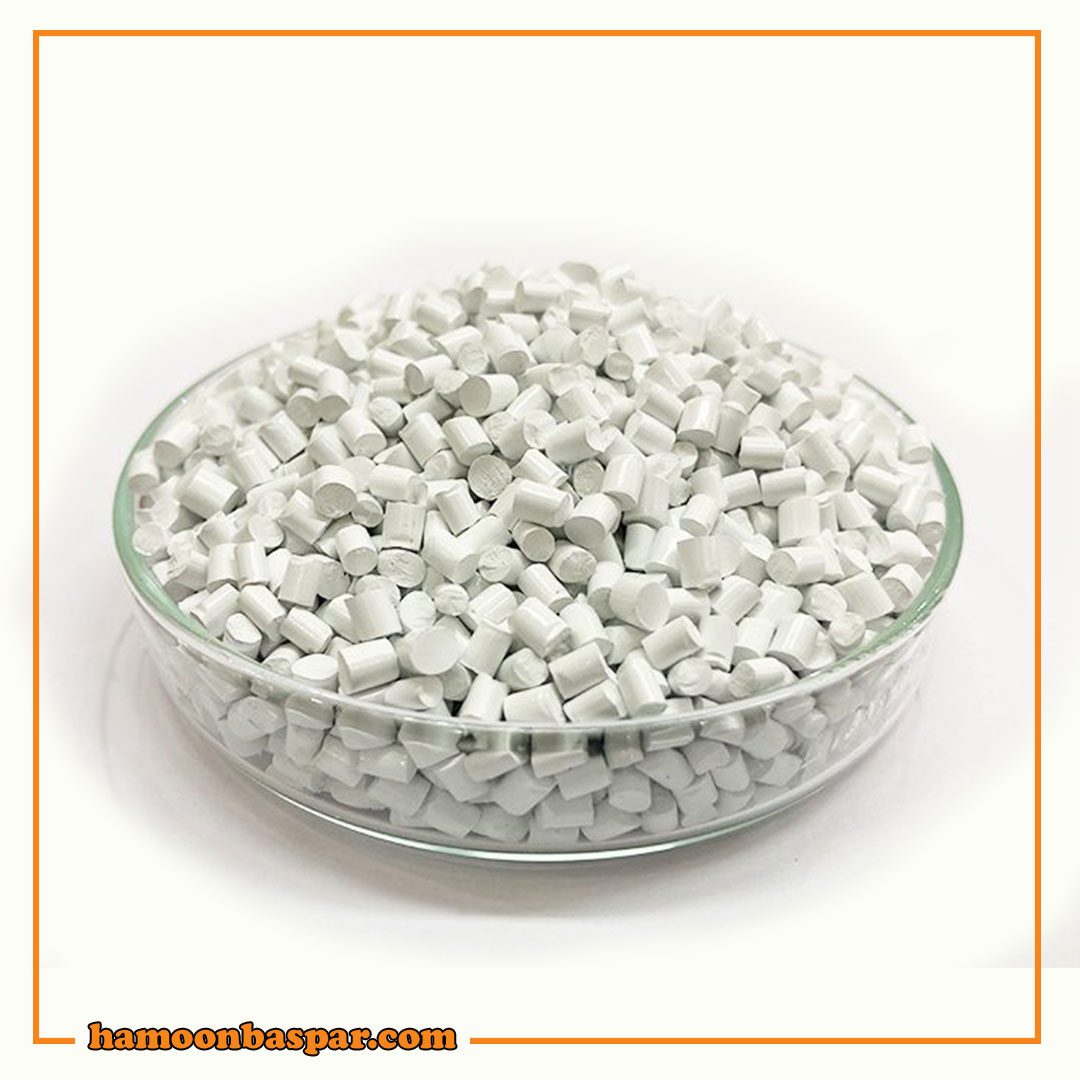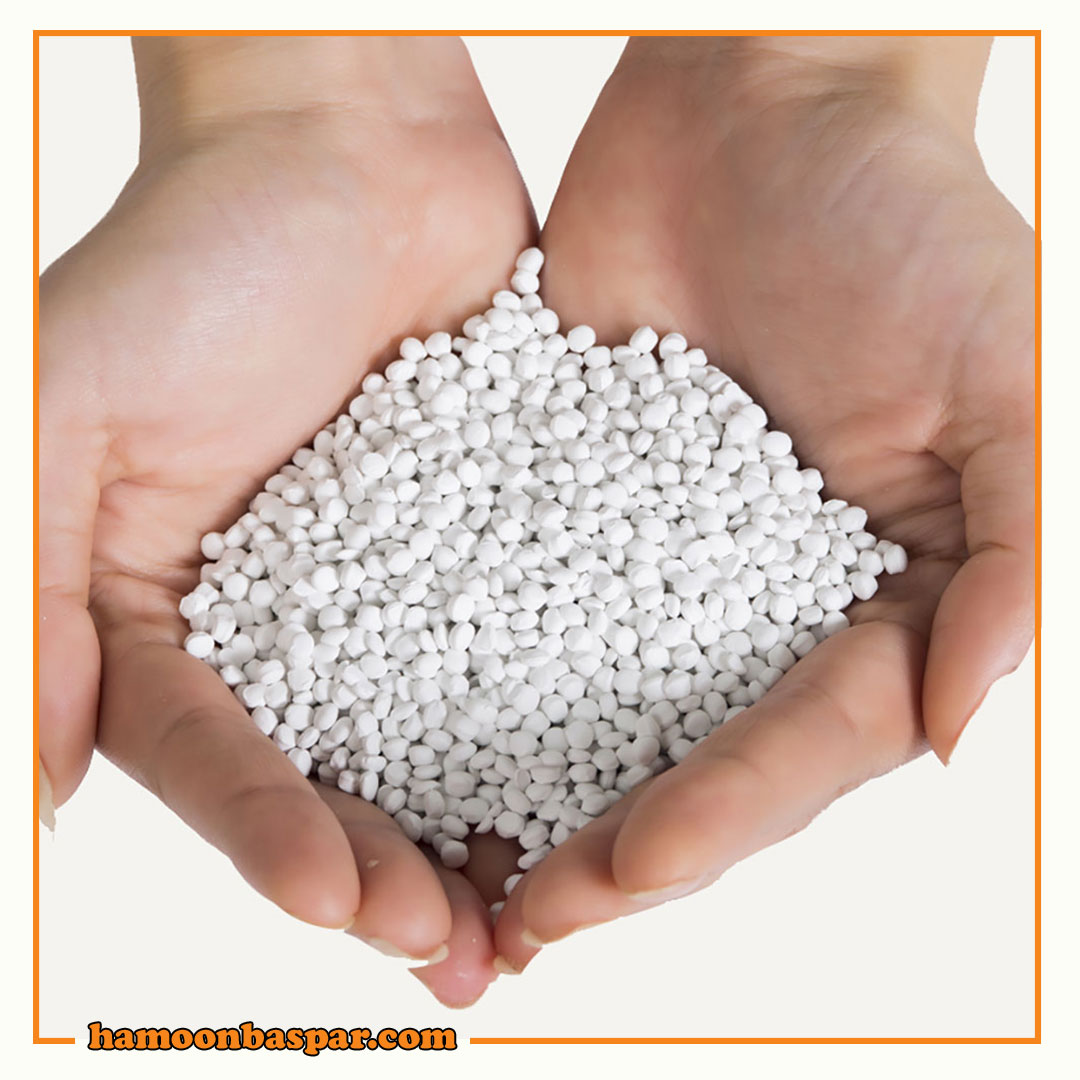White masterbatch production video at Hamoon Baspar
What is a white masterbatch?
White masterbatch is a concentrated pigment used to color plastic products. It consists of a white pigment such as titanium dioxide and a carrier resin, usually a thermoplastic polymer such as polyethylene or polypropylene. The white pigment is usually in the upper percentage of about 50-60% and the carrier resin makes up the remainder. White masterbatch is used to paint various plastic products such as films (using film grade white masterbatch), fibers, injection molded parts and extruded products such as pipes, profiles and sheets.
White masterbatch is one of the colored masterbatch which is a combination of titanium dioxide (TiO2). By adding these additives to polymers, the color and properties of the product change. The amount of titanium dioxide in the masterbatch can be between 15 and 80%. The price of the masterbatch depends on the percentage of TiO2.
A combination of polymer carrier titanium dioxide and other additives make a quality white masterbatch. To increase the whiteness and transparency of plastic products, it is suitable to use (TIO2). In various industries where plastic is the basic material for the production of all kinds of products, high quality white masterbatch is used because of its good features.
One of the most widely used masterbatch in industries is the white masterbatch. The combination of this masterbatch with polymer changes the color and properties.
The easiest way to prepare white masterbatch is to combine titanium dioxide and create white masterbatch. In fact, after being combined, white titanium is encapsulated under certain conditions, and by being exposed to high pressure and heat, the pigments are cooled and cut after heating.
Titanium dioxide is an excellent and suitable option for packaging and covering the surface, because it has a special background color. Its particle size is medium. Its background color is special. Its reflection has high light.
It is also used in addition to oyster pigment to produce products whose shiny appearance is important on the plastic surface, such as motor oil bottles or shampoo bottles. The reason for using oyster masterbatch is that oyster masterbatch has the ability to absorb ultraviolet rays. As a result, the absorption of this radiation increases the light of the object and makes the surface of the object more shiny. As a masterbatch producer, Hamon Bespar has launched quality products in this field.
Disadvantages of choosing a poor quality masterbatch
Reduced effectiveness: Low-quality white masterbatches may not provide the desired color or performance, resulting in an inferior final product.
Increased production costs: If the white masterbatch is of low quality, it may not be able to produce the required product or may need to be used at higher concentrations, which increases production costs.
Quality control issues: Products like pipes require high quality. And a poor quality white masterbatch can lead to quality control problems, resulting in inconsistent or defective products.
Environmental Impact: Some poor quality white masterbatches may contain hazardous chemicals or pollutants that harm the environment.
Damage to brand reputation: Using low-quality masterbatches can damage a brand’s reputation if the final product is poor or the use of masterbatches is identified.
Enjoy the stability, reliability and final quality of the products with our white masterbatches.
Important features and characteristics of white masterbatch
Some products are approved by the Food Standards Agency. These materials are heat resistant. Two other features of white masterbatch include increased titanium content and increased visible light scattering. To have better and more attractive materials, the amount of titanium dioxide in the masterbatch should be higher.
- It increases the transparency of the product.
- It is used to whiten the color of products.
- UV resistant.
- It is weather resistant.
- It is resistant to heat.
- It has high thermal stability.
- For the woven sack is antifibrillation.
Types of white masterbatch
There are several different types of white masterbatch available in the market, each with its own unique properties and characteristics. Some of the most common types of white masterbatch include titanium dioxide (TiO2), calcium carbonate (CaCO3), and talc. Each type of masterbatch has unique advantages and disadvantages that make it necessary to choose the right one based on the specific needs of the final product.
Titanium dioxide is the most popular and widely used white masterbatch due to its high coloring power and excellent spreadability. It is commonly used in the packaging industry to create white film and other plastic products. On the other hand, calcium carbonate masterbatch is an excellent choice for products that require high opacity and low gloss. It is commonly used in the manufacture of bottles, caps and other rigid plastic products. Masterbatch talc is a popular choice for products that require excellent chemical resistance and high temperature stability.
One of the significant advantages of white masterbatch is the ease of use and the ability to control the color of the final product. This allows manufacturers to create products that are consistent in color and clarity, making it ideal for mass production. In addition, white masterbatch is cost-effective and can be added at different stages of the production process depending on the desired final product.
As a result, white masterbatch is an essential additive in the manufacturing process of plastic products. With many different types of white masterbatch available in the market, it is essential to make the right choice based on the specific needs of the final product. Manufacturers can benefit from the ease of use and affordability of White Masterbatch, allowing them to create consistent, high-quality products that meet consumer demands.
Advantages and uses of white masterbatch
A quality white masterbatch has many uses, such as: extrusion coating, lamination, fibers, protective films, injection molding and many more.
Key markets that use White Masterbatch products include rigid and flexible plastic packaging for food, consumer goods and industrial products. plastic toys; white products; Industrial Piping All Standard White Masterbatch products comply with international food contact, toy and waste packaging regulations.
For customers who require a specific white color, Hamon Bespar offers a quick color matching service and creates custom white masterbatches to order. All custom formulated white masterbatches can include processing or end-use properties as required such as: anti-block, anti-static, anti-fog, UV stability, mold release, anti-bacterial, etc.
The following are the uses of white masterbatch:
- packing
- Home Appliances
- building construction
- agriculture
- Production of linear light
- polyethylene film
- Production of single-layer and multi-layer films
- Dark polymer film
- production
- packing
Normally, white masterbatch is used in ready-to-eat food packaging, refrigerated food packaging, shelf food packaging, pet food packaging, and lids, covers, and the like. .
The main use of white masterbatch is in the following industries:
Wire and cable, casting, extrusion, blown film, foam, sheet, tube, granule, EVA, preform, household appliances, toys, packaging materials, plastic bags, automotive industry, construction materials, sports equipment, bags Packaging, packaging bottles and other industrial plastic products.
The use of white masterbatch in the production of household appliances
Various household appliances are produced using plastic masterbatch, such as bottles, buckets, cups, glasses, baskets, covers, etc.
Application of white masterbatch in building construction
Due to the properties of white masterbatch, it is effective in construction purposes, including sheets of pipes and fittings, PC sheets, building films, pp corrugated sheets, polyethylene foam, solid sheets, geographical networks and geomembranes. It is suitable.
Application of white masterbatch in agriculture
White masterbatch is used in agriculture to produce many products such as mulch films, greenhouse films, textiles, fertilizer and pesticide bags, shade nets, tarpaulins, bale nets and twine.
The use of white masterbatch in the production of dark polymer film
Various methods are used in the production of polymer films, which are: extrusion, calendering, lamination, sheet production, bubble, blowing, coating, orientation, stretching.
Masterbatch and other additives are mixed together in the granule extrusion process, and after it is melted in the machine, it has a specific shape in the mold inside the machine. It is necessary to use white masterbatch for the high darkness of the produced polymer film.
The use of white masterbatch in the production of thin polymer films
The production of polymer films depends on the required applications and is done in different thicknesses. If you need to produce thin polymer films, you can use white masterbatch.
The use of white masterbatch in the production of linear light polyethylene film
One of the linear polyethylenes is the linear light polyethylene type, which has a low density. Linear polyethylene is used in the production of food and pharmaceutical packaging, plastic protectors, production of plastic bags, production of pipes and connections, production of cables. By using white masterbatch in the production of linear light polyethylene, there is a lot of flexibility in polyethylene, which makes the costs of this product low and affordable.
The use of white masterbatch in the production of single-layer and multi-layer films
There are different ways to produce plastic films. Of course, the production of these films is in single-layer and multi-layer models, and the blow molding method is used to produce these types of films. It goes without saying that in order to produce single-layer and multi-layer films, white masterbatch is added to the polymer.
What materials does the white masterbatch consist of?
The white masterbatch material has many variations. These products have different materials that a certain percentage of each material is used in the production of each product.
Materials such as titanium dioxide are used to produce white masterbatch. Titanium dioxide is a white substance that is used as a white pigment in many plastic materials and products, etc. Due to its good physical and chemical properties, this substance is used as a whitening coating as well as a matting agent in plastic products such as pipes, plates, car parts, etc.
Titanium dioxide is also used as a white pigment in the production process of white masterbatch. To produce white masterbatch, titanium dioxide is first mixed with plastic base material such as polyolefin polymers, polystyrene, polyvinyl chloride, etc. Then, by using devices such as stirrer or injection devices to evenly distribute titanium dioxide in the plastic base material, white masterbatch is produced.
The percentages of white masterbatch are:
- 15 to 20% base resin material
- Different pigments 40 to 80%
- 5 to 10 percent dispersants
- Necessary thermal stabilizers 0 to 2%
- Process assistant 0 to 5%
- Necessary filler materials from 0 to 40%
There is a good variety of white masterbatches. The price of masterbatch increases with the increase in variety. It should be noted that the price is very important in these products because the composition percentages are determined by people based on the price.
Features of the white masterbatch produced by Hamoon Baspar
- Our white masterbatches are the most effective way to achieve brilliant white color in your plastic products. Whether you are producing films, fibers, injection molded parts or extruded products such as tubes and sheets, our white masterbatches are of the highest quality. They ensure a clean, clear and professional appearance.
- At Hamoon Baspar, white masterbatches are made of high-grade micro-sized rutile white titanium dioxide with selective optical properties and a high refractive index.
- The equipment in the Hamon Bespar factory is of excellent quality and guaranteed to use excellent dispersion of pigments, to optimize performance through each product and to answer customer questions. This is why products made with white masterbatch fillers do not affect the rheological properties, but provide an excellent solution for color, whiteness and opacity at a decreasing price but increasing chunks per molding.
- Based on each customer’s request, our white masterbatches vary in pigment content, ranging from 20% to over 80%, which is combined with polyethylene resin and hand-picked additives for each machine run. .
- Then, our white masterbatch includes a high range of properties, for example, UV stability, anti-static, anti-bacterial, increased clarity and whiteness, anti-fibrillation and increased heat resistance, allowing processing temperatures from It gives 150 to 280.
- According to applications, for films that are complex to print and package, Hamon Bespar’s white masterbatch is one of the main options. Companies that produce plastic bags as carrier bags for agricultural and food products are our long-term strategic partners.
- In addition, extrusion coating and other types of molding such as injection and blow molding also require the appearance of our white masterbatch in their factory.
- Hamoon Baspar white masterbatch is sensitive to moisture and moisture absorption. Therefore, please use our moisture-proof woven sack bags immediately after opening them.
- Filled bags are loaded with wooden pallets.
Check out our most popular white masterbatch, if any of them do not meet your technical needs, please contact our sales department directly for a custom solution and custom pricing that fits your budget. - High quality materials are used to ensure consistent and reliable results. If you are looking for a good white masterbatch for pipes, fibers, injection molded parts and other plastic products, you can try Hamon Bespar white masterbatch.
- Highly stable and formulated for excellent dispersion and compatibility with a wide range of polymer resins
Create a brighter, more matte white that stands out in the marketplace. - Export quality, according to the highest international standards of quality and consistency.
- We have valid certificates, so product quality will not be a problem.
- As a leading exporter of white masterbatch, we have the resources to provide a consistent and reliable supply of high quality products to customers worldwide.
Our wide range of white masterbatches can be designed to meet specific needs. - As our products are suitable for various applications such as films, fibers, injection molded parts and extruded products, you will find us reliable and convenient.
- We are constantly researching and developing new masterbatches to meet the changing needs of the market.
- The best export-quality masterbatches are guaranteed, along with first-class and reliable customer service.
- We manufacture and export white masterbatches that provide UV protection that helps extend product life.
Preventing contamination of the produced white masterbatch during packaging and handling
To avoid contamination of the produced white masterbatch during packaging and handling, you should do the following:
Clean packaging and handling equipment
Packaging and handling equipment must be thoroughly cleaned and disinfected before use to prevent contamination.
Use suitable packaging materials
The packaging material used should be of good quality and not contaminate the white masterbatch.
Proper labeling
The packaging should be properly labeled to show the contents and any relevant information such as batch number, date of manufacture and expiry date.
Proper maintenance
Packaged white masterbatch should be stored in proper conditions such as a clean, dry and cool area away from any source of contamination.
Correct methods of transportation
The white masterbatch must be handled carefully to avoid any physical or chemical contamination. This includes using clean, dry gloves, avoiding contact with other materials, and using proper handling equipment.
By implementing these measures, you can ensure that the white masterbatch produced is not contaminated during packaging and handling and maintains its quality until it reaches the consumer.
White masterbatch production problems
The production of white masterbatch, like colored masterbatch, is a vital process that requires precision and expertise to ensure the high quality of the products. However, as with any manufacturing process, problems may arise during the production of the white masterbatch that can affect the quality of the final product. In this paragraph, we will look at some of the most common problems with white masterbatch production and ways to overcome them.
Insufficient dispersion of pigments
One of the most common problems in white masterbatch production is insufficient dispersion of pigments. Pigments are responsible for giving color to the masterbatch, and if they are not sufficiently dispersed, the final product will have uneven color distribution. This can be solved by using high-speed mixers that can disperse the pigments evenly throughout the mixture.
Poor melt flow
Another problem that occurs during white masterbatch production is poor melt flow. Melt flow is essential in the production of masterbatches because it determines how much material flows through the molding machine. If the melt flow is poor, it can lead to issues such as incomplete filling of mold cavities or surface defects in the final product. To overcome this problem, manufacturers can adjust the temperature and speed of the compounding process to improve melt flow.
pollution
Contamination is also a major problem during white masterbatch production. Contaminants such as dust, dirt or other impurities can negatively affect product quality. This problem can be solved by using suitable filtration systems that can remove impurities from the mixture before processing.
Creating air pockets during mixing
Another common problem in the production of white masterbatch is the creation of air pockets during mixing. Air pockets can lead to problems such as voids or bubbles in the final product, which can compromise its quality. To avoid this problem, manufacturers must ensure that their compounding process is thorough and use equipment capable of processing the material without entrapping air.
Consequently, while various problems can arise during the production of a white masterbatch, there are just as many solutions available to overcome them. Having a complete understanding of the entire production process and applying the right equipment and technology is very important to ensure high quality products. By addressing the issues discussed above, manufacturers such as Hamon Baspar can produce white masterbatches with consistent color, good melt flow, and no contamination or air bubbles.
Advantages of using white masterbatch for the environment
White masterbatch is a very useful and effective additive that is used in the plastic industry to give white or matte color to plastic products. However, the benefits of using white masterbatch go beyond aesthetic appeal. In fact, the use of white masterbatch can have significant benefits for the environment.
One of the main benefits of using white masterbatch is that it can help reduce the amount of plastic waste produced. When plastic products are made using white masterbatch, they are more likely to be recycled and reused. Because recycling white plastic is much easier than colored plastic. In this way, using white masterbatch can help reduce the amount of plastic that ends up in landfills and oceans, a major environmental concern.
Another advantage of using white masterbatch is that it can help reduce the energy and resources needed to produce plastic products. When plastic is colored, it often requires more energy and resources to produce, as more processing steps are required to achieve the desired color. By using white masterbatch, these additional processing steps can be avoided, which can help reduce the overall carbon footprint of plastic production.
In addition to these environmental benefits, the use of white masterbatch can also have economic benefits. For example, the use of white masterbatch can help reduce the cost of manufacturing plastic products, as it eliminates the need for additional processing steps. This could help make plastic products more affordable and accessible to consumers, while lowering production costs for manufacturers.
Overall, the benefits of using white masterbatch for the environment are clear. By reducing the amount of plastic waste produced, saving energy and resources, and reducing production costs, Masterbatch White is a highly beneficial additive that can help promote sustainability and environmental responsibility in the plastics industry.
9 points that you should consider when buying a white masterbatch
White masterbatch has the characteristics of bright and eye-catching color, high color strength, good dispersion, high concentration, good whiteness, strong covering power, good migration resistance and heat resistance, and is widely used in injection molding, molding Air is used. Keep the following points in mind when buying.
1- Whiteness
The whiteness of the masterbatch The white color is mainly provided by the titanium dioxide in the colored masterbatch, and many factors affect the whiteness of the titanium dioxide, including the size, shape, and size distribution of the titanium dioxide particles, the type and content of impurities, and the network of the dioxide particles. Titanium. In general, since the chlorination method has a higher purity of raw material titanium dioxide and less impurity in the preparation process, the whiteness of the titanium dioxide chlorination method is better than the sulfuric acid method. In the real white masterbatch market, many manufacturers of white masterbatch pretend to be titanium dioxide by adding calcium carbonate, barium sulfate and zinc sulfide with equal ash content, in fact, the whiteness of these mineral powders is not comparable to titanium dioxide.
2- Covering power
Covering power is also a very important indicator of white masterbatch. Good covering power means that the pigment has strong coloring power and with a small amount of masterbatch addition, the required color can be obtained. The covering power of white masterbatch depends on the choice of titanium. Compared with the processing technology, rutile titanium dioxide has a smaller and tighter unit network and a larger refractive index than anatase titanium dioxide, so its covering power and UV resistance are better than anatase for use in The same type of rutile titanium. White rutile titanium dioxide masterbatch, titanium dioxide particle size is small, the particle size distribution is narrow, and the good coating power in the masterbatch is clearly wider than the anatase titanium dioxide particle size distribution, and the dispersion performance is poor in the masterbatch. The coating power of ordinary calcium carbonate, barium sulfate and zinc sulfide is not comparable to titanium dioxide.
3- Dispersion
Dispersion has an important effect on the application of titanium dioxide in plastics. In general, the smaller the titanium dioxide particles, the better the dispersion and the higher the coloring power. When the film needs fine print, it is better to use white masterbatch. With excellent pattern transparency dispersion, layering and grain transparency are better, because the microscopic smoothness of the base layer is one of the determining factors for the quality of the printed pattern.
4- The amount of humidity
The amount of moisture in the white masterbatch also has an important effect on the performance of the masterbatch. In general, the moisture content should be controlled below 1500ppm and the exact requirement should be below 600ppm. In the injection molding process, all raw materials are dried before production, and in film production, they are used directly after premixing with the carrier. If the moisture content of the masterbatch is high, it will directly cause the film to tear and may also cause small bubbles. On the film, “crystal point” and other defects, the reasons for the high moisture content of the white masterbatch are influenced by the raw materials selected for the masterbatch and the process.
5- Smell
Some film producers notice a strange smell after using white masterbatches, which is absolutely not allowed on milk films and films that come into contact with food. This is mainly due to the presence of titanium dioxide in the masterbatch in the organic material. It happens if the coating additive is chosen inappropriately, or if the amount added is too high, or if there is a problem with the spreader used in the masterbatch production process.
6- Color selection
Due to the low reflectance of rutile titanium dioxide in the violet region, rutile titanium dioxide has a “yellow” color that makes the color product appear “old”. After adding a small amount of fluorescent whitening agent in titanium dioxide, it can absorb ultraviolet light with a wavelength of 300-400 nm and convert it to a UV light with a wavelength of 400-500 nm blue fluorescence, which can Create a white masterbatch.
7- Fluidity
White masterbatch fluidity can be defined as melt index (MI) low numerical flow difference, high numerical value
Good fluidity: Good fluidity means good processing performance, low machine torque, low energy consumption,
Time: In addition to the need for good fluidity of the masterbatch, it is necessary to pay attention to the fusion index of the masterbatch and the carrier resin, the general principle is that the MI of the masterbatch is higher than that of the carrier resin.
8- Print thermal sealing performance
In most cases, white packaging products require printing and heat sealing. If calcium carbonate is added to the white masterbatch, it will affect the transparency of the printed pattern. Improper or excessive dispersing materials added to the masterbatch also affect heat sealing and thermal sealing.
9- Light stability and weather resistance
White masterbatch generally requires light fastness of 7-8 degrees, weather resistance of 4-5 and temperature resistance of 280 degrees. These requirements mainly depend on the quality of titanium dioxide. Rutile titanium dioxide should be used to meet the above conditions.
Precautions when using white masterbatch
- To reduce the color difference of the fiber after color matching, the white masterbatch should be diluted and the mixing ratio should be controlled. Filament should not be less than 3% to 10%, short fiber should not be less than 1% to 3%, and monochromatic continuous filament spinning with tricolor equipment, white masterbatch should enter the extruder after mixing, and at the same time, in order to increase Self-melt mixing capability, a mixing device can also be added in the extruder section.
- White Masterbatch Mixing Method After the color formula of the dyed yarn is determined, the key to ensure the quality of the product is to spread the white masterbatch evenly in the polypropylene cuts before spinning. There are two special mixing methods. One is the heavy method and the volumetric method, after the white masterbatch is melted in the extruder, it is injected into the polypropylene melt with a small extruder, and it has a very good uniformity.
- When choosing the white masterbatch, it should be selected according to the range, the polypropylene color masterbatch can be divided into high concentration grade and low concentration grade, the high concentration grade white masterbatch cannot be used to match the color of the low concentration grade.
- The selected white masterbatch should preferably be the product of the same manufacturer, and to reduce costs, white masterbatch with high concentration should be used. White masterbatch pigments can be divided into high, medium and low grades. When matching color, different grades of white masterbatch should be properly selected according to the qualitative requirements of fiber formation. In order to avoid quality changes of the finished fiber due to the different light and heat stability of the pigment, the white masterbatch color that meets the fiber quality requirements and has the same level of light and heat stability should be selected when dyeing.
final word
Masterbatches are used in providing the color and properties of plastics. Because the polymer solvent does not evaporate, the masterbatches have a longer shelf life. There are special additives in the white masterbatch, which is responsible for making the resin compatible with the titanium pigment and, of course, gives the final product an ideal and suitable color. There are different types of white masterbatches available, which type depends on the percentage of titanium dioxide.
Despite the numerous and different masterbatches, in this article we talked about the white masterbatches, which is a well-known type of masterbatches. It is hoped that the above content was valuable and useful for you.
The need to use white masterbatch in various industries
In the world of production and industrial applications, color is not only about beauty. It can play a vital role in product identification, quality control and even safety. This is where the white masterbatch comes into play. Made of high quality pigments and carriers, white masterbatch is an essential component in creating plastic products that meet the needs of various industries. In this article, we will explore the vital role of white masterbatch in industrial applications and why it is essential for your business. Whether you’re in the automotive, packaging, or medical industries, understanding the benefits of white masterbatch can help you create high-quality products that meet your customers’ needs and stand out in the marketplace. So, let’s dive in and discover the benefits of using white masterbatch in your industrial applications.
Why do businesses need a white masterbatch?
White masterbatches are commonly used in the plastics industry for several reasons.
Aesthetics
White is a popular color for plastic products, and white masterbatches provide a bright, consistent white color that can enhance the appearance of a product. This is especially important in packaging and consumer goods where product appearance is important.
Easy to use
They are simple to use and can be added directly to the polymer melt during fabrication, making them a viable option for manufacturers.
UV Protection: A white masterbatch may contain UV stabilizers, which can help protect plastic products from UV rays, thus extending their life.
Enhanced Optical Properties: White masterbatches can enhance the optical properties of plastic products, making them appear brighter and more opaque.
Affordable
These pigments are cheaper than liquid pigments because they are more concentrated and require less ingredients to achieve the desired color.
Consistency: You can count on them to deliver consistent color from batch to batch, ensuring products look the same no matter when they’re manufactured. This is very important for brand consistency and meeting customer expectations.
Great for packing
Masterbatches offer great value packaging as they prevent food from spoiling. The protective layer can keep the content safe even in adverse weather conditions. Products made from white masterbatches have superior physical properties. They also help to increase the heat resistance, turbidity and whiteness of the product.
Due to the many advantages of white masterbatches, they play an important role in creating properties for plastic items. These masterbatches offer amazing benefits such as high quality end products, ease of operation, excellent dispersion, excellent color performance, and safety for food packaging. The numerous advantages of masterbatches have contributed to the growth of the plastics industry.
White masterbatch has 12 multiple times between 20 and 80%. In each of these orders, there is a certain amount of special items. In fact, titanium dioxide causes this classification. The ranking can be changed with different raw materials to create a good variety. This classification leads to the production of quality products.





















No views